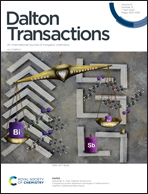Formation of mononuclear N,O-chelate zirconium complexes by direct insertion of epoxide into tetrakis(dimethylamido)zirconium: highly promising approach for developing an ALD precursor of ZrO2 thin films†
Abstract
A zirconium complex containing an N,O-chelate and alkylamide ligand has great potential for application in atomic layer deposition (ALD). However, the synthesis of this mononuclear Zr complex remains a major challenge because of the highly electrophilic nature and rich coordination of the Zr(IV) atom. Herein, a nonclassical and highly effective route for synthesizing the mononuclear N,O-chelate Zr complex was envisaged and verified using rationally designed reactions, involving the ring-opening insertion of epoxide into tetrakis(dimethylamido)zirconium(IV) (TDMAZ) at room temperature. To the best of our knowledge, very few studies in which mononuclear Zr complexes comprising alkylamide in combination with aminoalkoxide are structurally characterized. This method is extremely simple, atom economical, and easily scalable. Importantly, the produced precursor complex enables ALD of ZrO2 at a satisfactory growth rate (0.93 Å per cycle), close to that of the commercial ALD precursor CpZr(NMe2)3 (0.9 Å per cycle).



 Please wait while we load your content...
Please wait while we load your content...